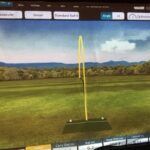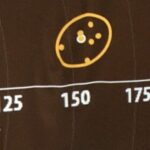As promised, he is a complete write up of my recent golf fitting. I should probably call it an iron fitting really because this is exactly what it was. I am not in any hurry to get all the pieces of my bag working together and it made more sense to concentrate on one area, which has always been a priority for me anyway. I went to my local golf shop here in France, La Maison du Golfeur which is a really good place if you are ever in the area.
Hopefully, this will give an insight into the fitting process in general, both from my point of view and what a good golf club fitter should be looking to achieve. I will also talk about some of the questions that any golfer should be asking as well as how to look at the mass of numbers that are thrown up by a detailed fitting. Ready? Let’s go!
What do You Want from Your Fitting?
As a starting point (and this is true for anyone who is thinking of going through a fitting whether in a big box store or as part of a boutique club build) it is important I think to have an idea of what you want to get out of the process. I don’t necessarily mean in terms of what you would like to be fitted into. This is no bad thing though. I mean, in terms of what information you want to get out of the process itself.
This is actually something that will affect the choice of where you get fit. For example, if you really just want the absolute basics of someone measuring maybe your wrist to floor and something that is going to give you an idea of your clubhead speed and hence throw out a shaft or two as possibilities, you might be fine with spending 15-30 mins in any big golf shop. In fact, you could do a lot worse than simply put your numbers into the Ping online fitting tool and go with that.
If you are looking to get fit for a few thousand dollars/euros/pounds worth of boutique Miura forgings with exotic aftermarket shafts, you probably want to make a day of it with someone who will build your clubs from a to z.
Clearly, these two options are very different, although both could reasonably fall under the umbrella of ‘golf fitting’.
My Fitting Expectations
I will talk you through my unique situation which might have a bit in common with yours as an example. I am a reasonable golfer who hasn’t been able to play as much as I would like over the last couple of years. When I play, I play. By this, I mean that I simply haven’t practised over the last couple of seasons, or at least it has been an absolute minimum.
Last year, I played (I think) six rounds of golf. I have an official handicap of 9.2 and this is probably about right. I haven’t handed in a card for a few years, but I was at a 6 or 7 level and have certainly gone up a couple of shots since then.
I am still a pretty reasonable ball-striker with a clubhead speed with my irons that is above average. My short game is exactly what you would expect of someone who will only putt and chip when it is actually on-course during a round. I have high hopes of changing this in the upcoming season, but this is my game as of now.
The next big issue is me. That is to say, my aging body! OK, I am not falling apart just yet and still enjoy working out, but I am approaching 50 and have arthritis in my shoulders and a few other aches and pains.
How Fast is My Swing?
My aim for this fitting was to see just how much clubhead speed I have lost and which options exist that might make it easier on my joints. I am also well-aware that my current iron set up is less than ideal for me. I play a fairly unforgiving head (the Mizuno mp 64) on a very stiff and heavy shaft (the project x 6.5).
Don’t get me wrong, I can certainly hit these clubs. However, I really need to swing in a fully committed way every swing over 18 holes and if I miss the centre (which is currently the case more often than previously through lack of practice) I both feel it in my arms and shoulders and see it in terms of results.
I have played a huge amount of different clubs over the last decade or so and I do havesome preferences. For example, I love playing blades. I like looking down at a sleeker topline, especially in my shorter irons. I don’t have a problem with chunkier irons necessarily, especially in the longer irons, but there are some looks I find off-putting. I generally don’t like a huge amount of off(set, although I have played happily with ping eye 2s which are very off set, so perhaps I am open to more than I think!
I wanted to find irons that do a few things then:
- Let me hit them without
beating balls twice a week. - Look good.
- Make life easier on my
joints.
I also have a swing fault common to many average golfers. I don’t deloft the club enough and, without having a huge flip, certainly present too much dynamic loft. This means that I hit the ball high and the idea of a shaft that makes me hit it even higher is potentially scary.
How Does a Fitting Session Actually Work?
So that was my thought process going in to the fitting. How did the session itself actually work?
A starting point for any fitting should be getting some data from what you actually use now. I warmed up hitting a few of my own irons and then we got some data.
There are different ways of getting this sort of clubhead/swing/ball data. In this session, we used trackman. Trackman is a really amazing bit of kit, but it does need someone who knows what they are doing to operate and interpret the figures.
Fortunately, this was definitely the case here. The fitter is also a friend and a really nice guy. I know that the figures coming out of the machine are ‘true’ in that they aren’t juiced up to make it seem like I am hitting the ball longer with any given club. You can see the figures on the various photos throughout this article and I will endeavour to present and explain them as I go too.
I was swinging the club fairly well but certainly no different to a normal decent ball-striking day. In my opinion, this is perfect for a fitting. If you happen to be there on a day which is very different to how you normally swing, the data becomes fairly useless.
Looking at the Data
This image is from one of my shots with my mp64s and it shows up my starting point quite well. It was a nice shot (for me!) It has flown 150m (about 165 yards) with my seven iron, lofted at 34 degrees (so quite old-school). You can see from the dynamic loft, that I am flipping at the ball but I knew this anyway.
It also showed that I really haven’t lost that much clubhead speed. This was a little over 142 kmh which works out to around 89 miles an hour. In fact, over the entire session, I was generally averaging somewhere in this area.
This looks like my current clubs are actually a pretty good fit, but it isn’t quite as clear cut as it might seem. This is one shot and when I look over the average of ten or more shots, the picture is slightly different.
I believe my Mizunos were the blue circle on the diagram below. If we look over a few shots, things change. My average distance was around 140m/155 yards. This still seems respectable and in all honesty, it is for me. The problem is that this distance is an average. The reason why it is 140 rather than perhaps 150 is because I wasn’t always able to get the ball out of the middle of the club.
Do My Current Irons Cost me Shots?
I didn’t completely mishit anything, but there were certainly shots that were not out of the sweet spot. Sometimes I might see a shot losing 10-15 yards. This brings me back to why I was doing the fitting in the first place. If I were simply looking to hit one shot and pick my best, this is still a great club for me. It looks awesome and the heavyweight, x stiff shaft is fine over a few swings.
When all the shots count and I am getting to the end of the round, the chances of hitting this perfect shot drop. I have to really make an effort to get a shaft that weights close to 130g to really go at the ball in order to get the most out of it. When the clubface isn’t the biggest, the chances of less than perfect contact are , well let’s say high!
Essentially, my average smash factor simply wasn’t good enough. Smash factor is a key thing to understand in a fitting. It is a number that divides ball speed by clubhead speed. A good way to think of it is as an efficiency rating. The higher the number, the more of your clubhead speed you are transferring into the ball. This number does have limits. For example, it can’t go above 1.5 for a driver and it will be lower the more loft a club has. For this club, a great number might be around 1.36/38. My average with my clubs was 1.28. This is simply not a good enough number for anyone looking to score on a golf course.
Without any arrogance (because in all honesty, my 9 handicap is distinctly average), I should have a better number than this. The conclusion is obvious and happily fit in with my reason for getting fit in the first place. I need irons that are easier to hit, both in terms of shaft and clubhead.
The Importance of a Good Fitter
This is where a good fitter is going to earn his crust. There are literally thousands of possible combinations of clubhead and shaft out there. The shop where I was fitted stocks perhaps 7 or 8 brands with full fitting carts for each. There is no way I could possibly wade through all of them.
The key here is, as my fitter said, to think of it being like a funnel. We start wide but based on what I already play, and work from there. There is part art and part science to this too. For example, something may give my great numbers but simply doesn’t appeal to my eye or doesn’t give me a feeling I like.
Florent (my fitter) asked me not to look at the shaft and clubhead (apart from at address) until I had hit a few shots. He encouraged me to give verbal feedback too. For example, how did the club feel in my hands? What did I feel about it visually? How was it to swing? What did I think was happening with the clubhead at impact?
These are all great questions and putting an answer into words as you work through the various combinations is a great way of helping the fitting work towards the best possible options. Bear in mind that these aren’t quite as obvious as you might think in terms of answers.
For example the expression ‘feel isn’t real’ is particularly apt here. I might say that I feel the clubhead is flexing a lot through impact but the numbers might show this not to be the case at all. The feeling we have as golfers is still really important.
Feedback and Feeling
I won’t list every single combination that I tried, but it is worth noting a few general tendencies. For example, the first shaft I tried was the project x 6.0, on a relatively similar Mizuno head to mine from the current range. Not surprisingly, this felt fine and it gave us just what we might expect: similar results to what I currently achieve, possibly with a little less need to really go after the ball given the shaft is slightly less stiff.
As I worked through lighter steel models, the feeling I had club in hand changed. A lighter shaft gave me the impression of having more weight in the club head itself, for example. I enjoyed the lighter steel shafts and felt like it let me swing more within myself. I have never been good at swinging 75%, but I understand how important it is and having a club that works with my on this is key to me being able to play pain-free and often (or at least more often!)
As I worked through the combinations, there were a few surprises. For example, I generally like ping clubs but couldn’t get on with the i230. This surprised me because it would have been on my shortlist at the start. I tried it with various shafts, from Ping’s own AMT to an NS pro, but it just never felt right.
Playing the Clubs on the Course
This is also an important part of the fitting process. Ultimately, when and if you decide to order whatever comes out of the fitting, you are going to be playing them on the course. If you don’t feel confident in what you are playing, who cares about the numbers?
As I narrowed down the possibilities, there were a couple of combinations that seemed to work. One was, unsurprisingly, one of the Mizuno heads. I wanted to love the 923 Tour. I did love it, but it was too much club for me in the same way that my own irons are. Perfect for when I am really swinging well and playing often, but too unforgiving for my current golf situation. The 923 forged and the 923 hot metal pro both worked really well for me. Paired with a lightweight stiff shaft (the Nippon NS PRO 950) the results were very nice. I think, in fact, either of these two heads on this shaft would give me a set of irons that would be really good for me.
The other option that gave me some really good results was the XXIO forged irons on one of their proprietary shafts. It felt like the ball was exploding off the club and was very consistent in terms of distance and direction too.There was one more club head which I kept coming back to…..which I will talk about later 😉
Trying Unexpected Shaft/head Combinations
So what stopped me from calling it a day at this point? I had hit a lot of shots with perhaps 10 different heads from Cobra to Callaway and maybe 20 different shafts. Well, there were two big things that meant I wasn’t quite ready to stop.
The first one was simply cost. I knew that I would not be putting a set of the XXIOs in the bag. The cost per club was several hundred euros and even if I loved them, I wasn’t going to be buying them, at least not today. The Mizunos are also premium in terms of price, but not quite on the same level.
The second thing was one of the big questions I had before my fitting and once again why it is so important to go in there with an idea of why we are going through the process.
I have written about the advantages of graphite shafts and I know that the definitely do make a difference in terms of vibration and therefore joint health. After passing an MRI scan a couple of months ago, I know that my shoulder joints aren’t in ideal shape and arthritis is likely to get worse over the next couple of decades. I want irons that are going to make golf a pleasure to play not irons that with aggravate pre-existing problems.
In fact, I was even prepared to go for something that actually had worse numbers than steel if I felt it would be better for my body. I had discussed this with Florent pre-fitting and he knew my thoughts.
Graphite vs Steel Shafts for a Faster Swing
This is where things got really interesting for me. I have played graphite before but not extensively. I certainly didn’t know as much as perhaps I should about graphite outside of the research I had done.
I went through the same process as for me steel shaft selection, working from heavy and stiff to somewhat lighter.
My results here were both surprising and actually really made me happy. To cut a long story short, graphite gave me what I had hoped for (vibration control, comfort, easy distance) but not what I was scared of (lack of control, ball flight too high and ridiculously excessive distance). There were a couple of shafts that I particularly enjoyed. The recoil f4 was very good, especially paired with the Mizuno 923 forged. It felt great and gave me a very consistent ball flight with a little draw that never became a hook.
The second shaft was the recoil dart 75. I didn’t know this shaft at all. I hit four shots that practically landed on top of one another with the first four I hit and the feel was again very comfortable. The only cloud on the horizon was that these three shots all turned over a bit and created a fairly strong draw. As many golfers who hit a draw, I am always scared of the one that starts turning left and keeps going.
Shaft Weight is Important
We thought that this might simply be a question of shaft weight. I was moving from 130g to well under 100 and actually nearer to 75g with some of the options.
At this point, we decided to try a surprising combination. We came back to one of the clubheads that I had hit previously and liked. It was the Wilson launchpad hybrid iron. Now, this is about as far away as you can get from a blade. It has a lot of weight down and off the back and a hybrid-like look.
In theory, this shouldn’t be in my wheelhouse. I definitely do not struggle to getthe ball in the air with my club head speed and my flippy dynamic loft. Surely this club is only for the slow-swinging senior? Just to really go against the grain, the fitter then paired this with a Mitsubishi Tensei Silver 70g shaft. This is a lightweight shaft meant to push the ball in the air. I had it in stiff, but a stiff here isstill a very long way from what I am used to!
The results were…..excellent. The ball certainly drew but no more than with heavy steel. I enjoyed the look surprisingly and also the hybrid like ping off the face. I did get a couple more yards height, but nothing ridiculous (33m from an average of 31 if memory serves for peak height).Most of all, it just felt like it was easy to hit.
I was averaging a comfortable 155m.170 yard carry and swing at around 143kmh/89 miles at the back end of a lot of shots, despite not feeling like I was trying to smash it. The front/back and lateral dispersion were both really good for me too.
This wasn’t the end though. It is important to see what happens if we push things a little further. We tried a very lightweight graphite and suddenly I really struggle to hit the ball properly. A couple were actually on the hosel. I couldn’t feel the club head at all. As we moved back upto the Tensei, everything fell back into place.
This looked like a nice fit then and certainly ticked a lot of boxes but it still left me with a couple of issues. As much as I quite like the idea of looking down on this semi-hybrid style head in a 5,6 or even 7 iron, what happens next? Could I play this in an 8 or 9 then move directly into a bladed wedge?
What Works vs What We Want
The answer is potentially one I had already looked at before the fitting. Ideally, I wanted something that looked and felt good, was easy enough to hit and blended in with the lofts of the launchpad (30 degrees in the 7 iron). If it was a different brand, would they have a shaft that worked as well for me?We didn’t actually need to look too far because Wilson has the d9 forged which seems to fit the profile perfectly. The shaft choice remains the same and the lofts are basically identical.
As you can see from the photos, it is also a very nice-looking club. It is bigger than my Mizuno, but not by a huge amount and gives me a lot more forgiveness. Of course, all that doesn’t matter if I don’t like it when I hit it.As you can see on the picture below, it worked very well. It is the purple group which was actually the best result I had in terms of dispersion, both front/back and left/right. It also felt very nice.
You might have noticed that I haven’t spent any time talking about fitting in terms of specs. There are a couple of reasons for this, mainly because I know more or less what is going to work because I am so tall.
Fitting for Length, Lie and Grip
We did have a look at the lie board with this final combination. I generally don’t like hitting on a lie board because I find it makes me swing a little bit differently, but it worked well here. For those that don’t know, a lie board is a square of plastic. The fitter will place a piece of tape on the sole of the club (and often on the face too) and you swing as normal, hitting a ball placed on the board.
The board leaves a mark on the tape showing if the club is hitting the ground in the middle, more towards the toe, or more to the heel. This allows the fitter
then to adjust the lie. I do have a few reservations about lie boards as a means of testing for lie angle, but it can be worth looking at without being taken as gospel.
My results here were what I would have hoped. Playing the d9 forged head on a tensei 70silver in stiff, 2 degrees upright and 1 inch overlength, I was consistently hitting both the middle of the clubface as well as the middle of the sole of the club.
So what happens next? This is the beauty of having a great golf shop with an excellent fitter. What we see on the screen doesn’t always correspond to what we see on the course. My fitter simply gave me the two different heads (d9 and Launchpad) and said to go and try them on the course.
As I write this, it is a day after I played 18 holes with the two irons. The results were slightly different to what I saw on the course, but that will be a whole other article which will be coming soon.





